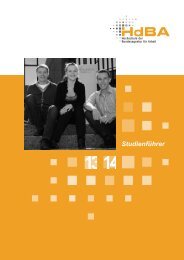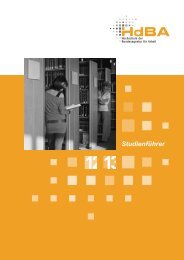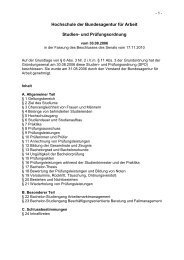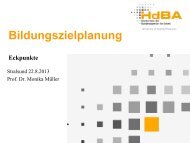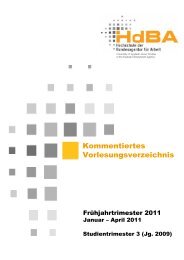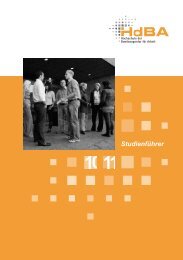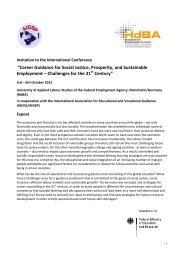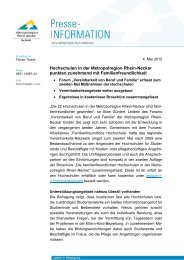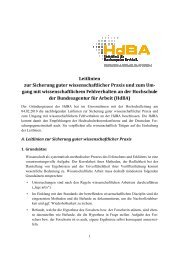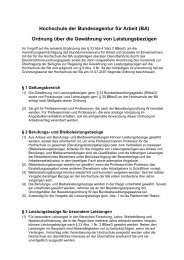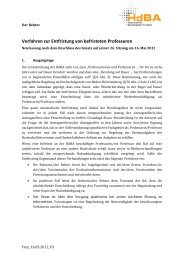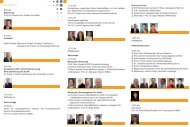Brain Drain - Hochschule der Bundesagentur für Arbeit
Brain Drain - Hochschule der Bundesagentur für Arbeit
Brain Drain - Hochschule der Bundesagentur für Arbeit
Create successful ePaper yourself
Turn your PDF publications into a flip-book with our unique Google optimized e-Paper software.
��������������������������������������������������<br />
�������������������������������������������������������������������������������<br />
������������<br />
�<br />
�<br />
Framework of Multicultural Counselling Competences (Sue) is based on extensive<br />
research concerning cultural identity, intercultural communication, mental health of<br />
minorities, as well as on counselling research. It was originally carried out for<br />
counsellors in the United States for typical counselling interactions involving a White<br />
(Euro-American) counsellor with a client from a different ethnic background. The<br />
starting point is that competences can be seen as a broa<strong>der</strong> framework for diversitysensitive<br />
approach in counselling (e.g. Nelson-Jones 2002). This viewpoint is<br />
supported also by the latest research: there seems to be a positive correlation<br />
between clients’ ratings of Multicultural Counselling Competences and clients’ ratings<br />
of counsellors’ general competency (Fuertes & Brobst 2002; Farga 2004).<br />
The roots of the Multicultural Counselling Competences are in the framework of<br />
cross-cultural counselling competencies by Sue et al. (1982). In that position paper<br />
the authors outline three dimensions of cross-cultural counselling competences:<br />
beliefs and attitudes, knowledge and skills. The first dimension deals with the<br />
counsellor’s attitudes and beliefs about racial and ethnic minorities, the need to check<br />
biases and stereotypes and develop a positive orientation towards multiculturalism.<br />
The research has emphasised the importance of the counsellor’s awareness of his or<br />
her own culture and of the client’s culture. To be able to place oneself in the situation<br />
of a person from another culture, one has first to become aware of the effects of<br />
one’s own culture and values on one’s action. The second dimension proposes that<br />
the culturally skilled counsellor has a good knowledge and un<strong>der</strong>standing of his or<br />
her own worldview has specific knowledge of the cultural groups he or she works<br />
with, and that he or she un<strong>der</strong>stands socio-political influences. The last dimension<br />
emphasises specific intervention techniques and strategies needed in working with<br />
minority groups. Multicultural Counselling Competencies by Sue et al. (1992; 1996)<br />
revises the original three-dimensional framework by adding to it the following three<br />
characteristics of a culturally competent counsellor: 1) awareness of his or her own<br />
assumptions, values and biases, 2) un<strong>der</strong>standing of the worldview of a culturally<br />
different client as well as 3) an ability to develop appropriate intervention strategies<br />
and techniques. Due to the fact that each of these characteristics are described as<br />
having dimensions of beliefs and attitudes, knowledge and skills, Multicultural<br />
Counselling Competencies define a total of nine competence areas (as shown in<br />
Table 1).<br />
In or<strong>der</strong> to encourage educators and practitioners to implement these competences,<br />
Arredondo and Toporek (1996) expanded and mobilised them into measurable<br />
behaviours and activities. In this expanded version, the authors described a<br />
framework for the development of the competences and included explanatory<br />
statements for each competence along with strategies for achieving them. The<br />
newest version of the competences differentiates multi-culturality and diversity. Multiculturality<br />
refers to ethnicity, race and culture, whereas diversity means to other<br />
individual differences including age, gen<strong>der</strong>, sexual orientation, religion, etc.<br />
171




